Braces have become a part of modern day life for those who value and understand good dental health. The tiny metallic shiny pieces attached to the teeth have become a symbol of progress and development of the community. It symbolizes all around progress and affluence of the society that patronizes braces.
A perfect set of teeth is every one's dream. Everyone desires a beautiful smile. It adds to the personality and leaves a permanent impression on the beholder. Perfectly arranged teeth function best and last longer in the mouth. They help chew food better and help in the digestive process and therefore are important for good health.
The treatment with braces is a major step towards providing perfect and permanent alignment to the teeth in each jaw and to the teeth in the opposing jaws.
The end result of treatment with braces can be simply stunning. It is a result oriented procedure. It is transparent in nature. The patient and the family can experience the joy of positive progress by merely checking out in the mirror at home.
The results are just beautiful. Anything well organized looks beautiful. Unfortunately, the misinformed consider treatment with braces a beauty treatment. Nothing can be further from the truth it is a complete and essential health service backed by research and technology of the highest standard.
It is in the interest of the parent / patient to seek advice from the expert. A large number of persons of all types claim to have knowledge on the subject of braces and offer unnecessary advice which can be called misguidance. This is unfortunate and deprives a large number of people of the benefits of this great service.
The booklet is an attempt, in simple language, at providing basic questions that arise in connection with braces.
HISTORY
Braces have a glorious history of one hundred years of research and development. They were first introduced over ONE HUNDRED YEARS AGO in the USA. The present technology has evolved by incorporating recent advances in material sciences and technology.
Braces today incorporate a fall out from space research through the use of very advanced alloys and composite adhesives for use in the mouth for aligning teeth.
In India treatment with braces was introduced in the late sixties and since then has progressed by leaps and bounds being first patronized by the metros and now by populations in the smallest of towns. The universal desire to look good has taken it's toll. This greatest of treatments available to man is now erroneously considered a beauty treatment. This is unfortunate and a typical example of familiarity breeding contempt.
TEETH AND THEIR SUPPORT
The teeth are not embedded in the bone. They are suspended in the bone by means of very fine muscle tissue which is like the shock absorbers in cars and scooters. This is the best friend of the braces and the technology that makes teeth move into perfect positions. These tiny muscles are very well supplied with blood vessels bringing nutrients to the supporting structures. These muscles and the surrounding bone of the jaws are best preserved when the forces falling on them are perfectly absorbed by the supporting structure.
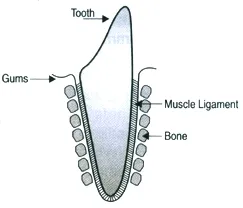
ARRANGEMENT OF THE TEETH IN THE MOUTH
Natures arrange the teeth in the mouth in the form of an arch along the curvature of the jaw bones. Teeth in each arch, both upper and the lower. must be aligned with their neighbor in a prefect form .This helps chewing and prevents food being caught in between the teeth.
When the teeth are crowded and haphazardly arranged, there is a great chance of food getting lodged in between the teeth. This is difficult to clean with the tooth brush. The decaying food causes bad breath, disease of the gums and also decay of the teeth from the sides. When left unattended this leads to early loss of teeth and chewing efficiency. disrupting the digestive process, leading to major health problems.
Teeth of the upper and the lower jaws meet each other like gear wheels of mechanical systems. In order that a machine moves perfectly, the gears must mesh perfectly. So it is with the teeth.
Bite is the way the upper and the lower teeth meet on closure. This is very important for the chewing process, the longevity of the teeth and supporting structures and the health of the temporo-mandibular joint which controls the movement of the jaw. Serious problems of the joint may occur when the bite is disturbed leading to severe pain in the area just in front of the ears where the joint is located.
The upper and the lower teeth have a box and lid relationship. The lid always closes outside the box. Same with the teeth. The upper teeth always close outside the lower. The big difference here is that the box represented by the lower jaws falls down and the lid represented by the upper jaw stays in place and is immovable.
WHY DO YOU NEED STRAIGHT TEETH?
Treatment with braces can improve your dental health and change your facial appearance for the better. It can boost your self - esteem. This is beneficial to social and career success. It also helps improve one's general attitude towards life and the quality of life itself.
A pleasing appearance is a vital asset in today's highly competitive world. Treatment with braces can help achieve a high level of self confidence. Straight teeth are easier to clean and last longer and enhance the quality of the smile. Some problems can cause excessive and abnormal wear of tooth surface leading to misalignment of the jaw joints which can result in severe pain in the neck face and the front of the ears.
During chewing a tremendous force is exerted on the teeth. It has been measured at 250 lbs / square inch at the molar teeth. It would not be out of place to give you an idea of this force value, if this force were to fall on your finger it would be compressed to the thickness of your newspaper.
Nature has designed the skull to absorb this tremendous force value through excellent engineering. During chewing this force travels down the long axis of the tooth and into the bone through the tiny muscles of the suspensory apparatus holding the teeth in the bone, and then into the bone itself which disperses the force along buttresses in the skull where it settles down.
When the teeth are not straight or properly arranged with the bone in respect to their long axis, the force is misguided and destroys the supporting structures of the teeth, loosening them and hastening their fall. We have all had the experience of driving a nail into the wall, so long as the stroke from the hammer travels along and long axis of the nail, everything is great, but the plaster falls off the moment a stroke is misdirected. This is the closest example in everyday life that I can offer for the effect of force on supporting structures.
CONDITIONS REQUIRING BRACES
This is the most simple step of all. Just stand in front of the mirror and check out the following.
Are your teeth
- Crowded like passengers in an overloaded bus?
- Upper teeth protruding far ahead of the lower
- Lower teeth closing ahead of the upper this is called cross bite
- Upper rear teeth, i.e chewing teeth, closing inside the lower teeth
- Teeth falling into extraction spaces
- Upper front teeth falling backwards and grinding against the lower teeth
- Lower teeth hitting the roof of the mouth behind the upper teeth on closing
- Pain in the jaw joint just ahead of the ear
- Clicking sound in the joint during opening and closing
- Seen from the side the lower jaw looks very small
- Seen from the side the lower jaw looks very large
If one or more conditions exist. Then you need to consult an ORTHODONTIST
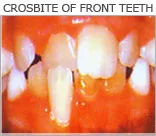
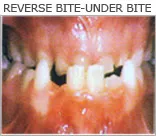
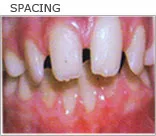
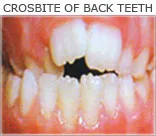

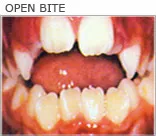


CAUSES LEADING TO THESE CONDITIONS
Conditions requiring braces are of two types
- Genetic and Acquired
Genetic Conditions are inherited from either or both parents. The person may have large tooth size from one parent and a small jaw size from another. These then produce a situation wherein the teeth either protrude out or are arranged in a haphazard crowded manner. A large or small lower jaw may be inherited from one parent and upper face may be from another. Thus causing disproportion in the face.
Acquired conditions are generally associated with the growing years specially when the milk teeth are falling off and new permanent teeth are taking their place. Teeth which fall off before their time must be replaced with space maintainers to hold the space for the successor tooth. Otherwise the space may get filled up by the adjacent teeth leaving no place for the new tooth to grow into. Teeth which stay on in the gums even when their successors have erupted need to be removed so that their place may be rightfully taken by the successor tooth.
The milk teeth have a very important role to play and must be preserved and looked after till they fall off. Decay and early loss must be taken care of at the earliest.
Habits such as thumb sucking and tongue thrusting can lead to conditions requiring treatment with braces, These habits need to be corrected at the earliest to avoid major problems with the teeth and the supporting bones
It is best to visit the ORTHODONTIST during the age of 8 to 11 year. This is the period when the teeth in the mouth are a mix of the milk teeth and the permanent teeth and a lot of changes are taking place in the mouth and the face.
WHO SHOULD YOU VISIT FOR BRACES
Braces are special dental treatment. The specialist giving braces is a dental specialist called an ORTHODONTIST the basic qualification to be called an orthodontist is a M.D.S (Master of Dental Surgery in Orthodontics) this post graduate qualification is obtained after a graduation course in dentistry called B.D.S.
M.D.S like other post graduate qualifications in the medical field is awarded in a number of dental subjects. EVERY M.D.S DEGREE HOLDER IS NOT AN ORTHODONTIST.
Your best bet is to be treated in a specially equipped ORTHODONTIC CLINIC
An orthodontist is never far & is definitely worth visiting.
DIAGNOSIS FOR TREATMENT WITH BRACES
Treatment with braces is an elaborate procedure. Like in any medical condition, it is important to know the exact problem before a prescription is written; similarly it is important to know the exact problem of the patient before the treatment can be planned and the braces prescribed.
A diagnosis would require a set of PLASTER MODELS of the patient's teeth,
An analysis of the x ray of the head in a set position which may need to be repeated during the
treatment this is called a LATERAL CEPHALOGRAM.
An x ray of the jaws for the position of unrrupted teeth and root position called an OPG.
A SET OF PHOTOGRAPHS of the face front, side, teeth in closed position and open mouth.
These help in diagnosis and also help serve as a record of the case at the start of the treatment, to be compared later with the end result. The need to reduce the number of teeth in the jaws should not be a cause for alarm to the patient / parent. This is essential if space has to be created for the perfect alignment of the teeth in the jaws.
Appliances are fabricated as per the need of the case. There may be more than one appliance required for the completion of the treatment. The appliances are job specific and are fabricated as per the need of the patient.
Just as there is no single pill available at the chemist for all the ills in medical sciences, there is no single set of braces available to fit all problems of the teeth.
TYPES OF BRACES
Braces are generally of two types.
1. Removable braces and 2. Fixed Braces
The removable braces as their name suggests, can be removed from and placed in the mouth by the patient. They are made of wire and plastic and are made outside the mouth on the plaster models of the mouth of the patient.
Removable braces require a great amount of co operation from the patient in order to produce the result. It is not possible to control the movement of each tooth of the patient during the treatment. The present day specialists do not prefer to treat with removable braces because of lack of patient co operation and inefficiency of the appliance system.
The fixed brace are their name suggests are fixed to the teeth and can not be removed by the patient at his own free will. They are made of steel or ceramic and represent the greatest of advances in technology.
Fixed braces do not solely depend on the co operation of the patient. The result is excellent as they provide control on individual teeth. The part that is fixed to the tooth is called a BRACKET for the front teeth and a TUBE for the molar or posterior teeth. Both the bracket and the tube are examples of the ultimate in engineering and technology.
The wires that are used are a fall out of the alloys used in space research. Alloys such as Nickel - Titanium and Copper and Nickel Titanium help move teeth into perfect position these wires are very comfortable and exert very comfortable forces over a long period of time thus reducing the number of visits.
The latest wires are thermal sensitive. They go soft at low temperature and harden up as the temperature rises in the mouth thus delivering constant force.
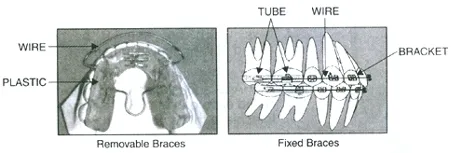
COMPONENTS OF BRACES
Braces are a complete force system capable of generating and transferring force to move teeth and align them in perfect positions. Braces consist of TUBES that are attached on the grinding or molar teeth and BRACKETS which are attached to all the rest of the teeth, premolars, canines and incisors, in the mouth. The BRACKET and the TUBES hold the WIRE which transmit the forces to the teeth. Sometimes elastics made of latex are used to generate extra force in the appliance. Teeth can be moved every which way-up, down, left, right, rotated, and pushed into the bone. In short everything that is needed to give the perfect setting to the teeth.Both the upper and the lower teeth carry similar appliances. The appliance is complete only when placed on both the upper and the lower teeth.
HOW DO BRACES WORK?
Braces move the teeth with their support system through the bone. They work on the simple principle of bones resorbing under pressure and forming under tension. When force is applied on the tooth, the bone on the side on which the pressure is applied slowly dissolves out and the tooth moves into the gap thus created. New bone forms on the bone on the opposite side which is experiencing the pull of the force. All this happens simultaneously.
Do braces only move teeth? No they are capable of manipulating the direction of growth of the facial bones. Growth of the bones is determined genetically. What can be achieved is the change in the direction of the growth of the facial bones.
Small lower jaws that close far behind the upper jaws can be made to grow favorably if and when treated in the growing years. The same applies to upper and lower jaws which are seen to be growing far ahead of their opposite member.
Appliances placed outside the mouth called extra oral appliances may be required to achieve these corrections.

BEST AGE FOR TREATMENT
Humans are blessed with two sets of teeth in a life time. The milk teeth for the child years and the permanent teeth for the adult age. The transition from milk teeth to the permanent teeth takes place over a period of time usually from 6 years to 13 years of age. Most problems develop during this period. It is good to see a specialist ORTHODONTIST during this period.
Conditions requiring braces for treatment can be prevented to a good extent, and those conditions which have appeared can be prevented from growing in severity during this transition period from the milk to the permanent teeth. It is a good idea to start early and try to reduce the severity of the problems which have developed.
Problems to be treated with braces are problems of the growing child. These are best treated during the growing years. Children grow very fast at puberty. There are two periods well recognized for treatment. These are the pre puberty and the post puberty growth periods. These are the best times to treat as changes in the face can best be achieved at these times.
However, treatment with braces can be taken at any time. The age is not the guiding factor. What
is important is the nature of the problem to be treated and the condition of the teeth and their
supporting structures. That is if the gums and the holding soft bone are healthy, braces can be
prescribed if indicated. Best bet is to consult the ORTHODONTIST
Fixed Braces are never placed on milk teeth
TREATMENT PROCEDURE
The treatment would generally consist of the following steps:
- Consultation
- Records and investigations, consisting of x rays and plaster models and history
- Case analysis and case discussion, treatment planning
- Completion of all general dental work like filling and extractions
- Fabrication of appliances and fitting
- Follow up visits till treatment goals are achieved
- Models and x rays to compare with the record and evaluate the result. End of active treatment
- Retention appliance. To retain the result and allow setting down
IS TOOTH EXTRACTION ESSENTIAL?
The diagnosis is the most important part. It is very essential to understand the nature of the problem being treated. Once that is done the treatment plan decides the requirement of the appliance
If the diagnosis indicates it, it is essential to extract some teeth for the purpose of the treatment. This should not cause any alarm, It is an internationally accepted procedure and the decision to extract is taken with all considerations in mind.
Imagine a school bench meant for four children that gets occupied by six. The result is that the children have to sit haphazardly. If the teacher were to insist on order, then either the bench would have to be made bigger or the number of children reduced. In the mouth, a similar situation arises, since the jaw bones can not be made to grow to take all the teeth, some teeth have to be reduced in number for the others to be arranged perfectly well.
The decision is always made according to the space available in the bone as compared to the space required by the teeth to be arranged perfectly. If the space available for the teeth is less, then some teeth will have to be removed to adjust the arrangement of the teeth in the mouth
TREATMENT OBJECTIVE
A well treated case will have teeth well set with no spaces in between them, no rotations, near perfect setting (almost like in a denture) roots well aligned and paralleled, no cross bites, teeth well angulated and perfectly tipped not tilted too far back. This will add to the beauty of the smile and help retain the teeth for a long time without decay and gum problems.
WHO WILL GIVE ME THE BEST BRACES?
Always trust a qualified dental specialist for braces. The qualification is an M.D.S in Orthodontics.
EVERY M.D.S DEGREE HOLDER IS NOT AN ORTHODONTIST.
Many dentists claim to be able to treat with braces. You would be taking a big risk by submitting to treatment with an unqualified Orthodontist. The conditions requiring braces can easily be checked out in front of a mirror. If you are in doubt about the need for the treatment, consult an ORTHODONTIST. Remember an ORTHODONTIST is never very far and is worth the visit.
Two systems are used for treatment with fixed braces. Both are imported. The older outdated system is popularly called the Australian system. This is not popular even in Australia. The newer system is the American system of treatment this is accepted world wide and is the current favorite because of it's ability to deliver good results comfortably.
It is important to check out the system of braces used by the orthodontist. Mostly the specialists are up to date with knowledge. At present, Pre adjusted Edgewise Braces also know as straight wire braces or American system are being widely used throughout the world. These are high tech, comfortable and produce good results. The visits are also fewer as compared to the earlier system of braces.
Of course the most important aspect is the skill of the ORTHODONTIST, THE REGULARITY OF THE PATIENTS VISITS AND THE CO OPERATION OF THE PATIENT
TECHNOLOGY AND BRACES
Technology plays a very important part in Braces. Modern day braces incorporate the highest technology and research in Material Sciences, Mechanics and Biology. The better the technology the better and more comfortable the treatment.
Outdated technology can lead to severe discomfort during treatment, lengthy treatment, damage to tooth structures, decay in the teeth and ordinary treatment results causing disfigurement of the face..
It is in the interest of the patient to find out the level of the technology practiced by the orthodontist
TIME REQUIRED FOR TREATMENT
Time for treatment varies from case to case. However, treatment with braces is a very transparent procedure. One can easily stand in front of the mirror with the pre treatment plaster models in the hand and check out the progress of the treatment at any given point in time.
There is no known method to predict the exact time for the treatment. The estimates given are on the basis of past experience of treating similar cases.
There may be some cases which show slow progress, however, no treatment goes on just endlessly without showing any significant progress compared with the pre treatment plaster models.
TIME REQUIRED FOR TREATMENT
Two kinds of costs should be considered in treatment with braces. One the direct cost, the amount quoted by the ORTHODONTIST and the indirect cost in terms of regular visits, time, discomfort, treatment result and length of treatment. Braces are considered expensive the world over. The reasons are simple, it is a very highly skilled job and requires expensive materials.
The experience of the Orthodontist, the quality of the braces and the problem to be treated decide the cost of the treatment. You could choose out dated low technology cheaper braces but will end up paying more in terms of hidden costs such as extra visits longer treatment time, more discomfort, poor results. Cost of treatment varies from city to city. There is no standardization of charges for treatment. Creamic braces are very expensive but offer no treatment advantage.
Treatment with braces is purely result oriented. A comparison with your pre treatment record will tell just how well you have been treated and the time taken for the treatment to be completed.
PRECAUTIONS WITH BRACES
There may be some discomfort at the beginning of the treatment and when new wires are placed on the teeth, some wire may poke at the soft tissues of the mouth. These are very small problem and can be attended to instantly. Better quality braces are very comfortable and the patient does not even feel their presence in the mouth.
Certain foods are not allowed during treatment with braces chewing on ice, hard candy, hard chocolates, bones and biting into fruits like apples is not allowed.
Braces when subjected to heavy pressure can break off from the tooth surfaces. This means discomfort, extra appointments and a delay in the treatment. Also the wires may hurt the tissues in the mouth causing injury. This can be easily avoided by following the instructions of the ORTHODONTIST.
PRECAUTIONS WITH BRACES
Surgery is a new dimension that has been added to Orthodontics. This is a combination procedure carried out by the Orthodontist and the Oral & Maxillofacial Surgeon, another dental specialist, to produce the best possible result for the patient.
There are some defects that may require surgery to correct to perfection. These are generally related to large jaws and open bite cases. With the advent of adult treatment the number of cases going up for final surgical correction is increasing. Teeth can be moved with Braces. But when the problem involves the bones of the face, they have to be set surgically.
The need for final correction with surgery is generally determined at the diagnosis stage. However, it is always treatment with braces before surgical correction
COSMETIC DENTISTRY AND BRACES
Some doctors offer cosmetic dentistry in lieu of treatment with braces on the plea that braces take longer time to complete.
This is pure misguidance. Brace cannot be substituted with cosmetic dentistry. Changes with braces are permanent as compared to a camouflage treatment with cosmetic dentistry which is temporary in nature and needs to be repeated. Braces create changes in the position of the teeth from the roots upwards. The changes are longer lasting and ensure health and longevity of the teeth. The basic treatment philosophy is different. Therefore, there can be no comparison.
The plea that braces take longer is an attempt to mislead the patient on the advantages of treatment with braces.
WHO IS AN OTHODONTIST?
An Orthodontist is a Dental Specialist trained in the art and the science of the treatment of crooked and protruding teeth and misaligned jaws.
The special training is obtained after graduation in Dentistry. Presently it takes a minimum of three years to complete the course.
A good ORTHODONTIST has the vision and the foresight of an Architect and can mould the face and correct the alignment of the teeth, thereby ensuring long life for the teeth and health of the jaw joint which is situated just in front of the ear.
An Orthodontist is a rare entity and is a highly skilled Dentist working with wires and other metallic objects in the small space of a child's mouth. The proficiency lies in the ability of the Orthodontist to place metallic appliances in a child's mouth without hurting. It is a pleasure to watch an Orthodontist conduct his art in an Orthodontic Clinic.
The Orthodontic treatment is the biggest and longest treatment in Dentistry. It produces results which are simply stunning and help change the personality and attitude of the patient for life.
AN ORTHODONTIST AS A SMILE ARCHITECT IS AN ASSET TO THE COMMUNITY.
EPILOGUE
The art and the science of the treatment with BRACES has always been held in great esteem by those who recommend it, those who practice it and those that patronize and submit to the great treatment.
An ORTHODONTIST'S profession is a conveted profession attracting the very best of talent passing out of the Dental Colleges all over the country. The Profession is demanding and requires excellent foresight and skill to be able to deliver the goods.
Not many people are familiar with the term ORTHODONTIST the specialist that treats with BRACES. The best of the educated in the country and that includes doctors, architects, lawyers, members of the press and well read professors are unable to identify with the profession. It is also true that those who came in contact with the ORTHODONTIST never forget them either.
BRACES have so far been provided to the public through the General Dental Practitioner who has been the basic service provider in the Dental Profession. This has worked well all these years. However, the tremendous progress in the subject has left the General dentist very far behind. It is in the interest of the patient to visit and consult the ORTHODONTIST specialist who is to deliver the goods.
I have been aware of the fact that almost nothing is available to the general public with regards to BRACES. This is a maiden attempt at providing basic information to the treatment seeker. A feed back will help improve the next edition of the booklet.
Dr. Jayant Dehadrai
M.D.S
Orthodontist
ABOUT THE AUTHOR
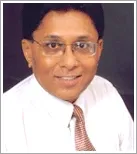
Dr. Jayant Dehadrai obtained his M.D.S in ORTHODONTIST form the Dental College & Hospital, King Georges' Medical College Lucknow in 1974. He settled down in Ahmedabad with a private practice in May 1975.
He is a Rotary Foundation Group Study Exchange Alumni and was awarded the prestigious prize to tour Scotland in 1982. He is a past President of the Rotary Club of Ahmedabad, a Past President of the Dental Practitioners' Society Ahmedabad and Indian Dental Association Ahmedabad Branch. He is the past Hon. Secretary of the Indian Orthodontic Society, the premier specialist professional body for Orthodontists in India, having served the Society from 2002 -2006.
Dr. Jayant Dehadrai lectures extensively on practice management. His main concern is the propogation of the subject of Orthodontics. His mission statement “ORTHODONTIST SHOULD BE A HOUSEHOLD WORD”
He has tremendous talents as a master communicator and this booklet is an attempt at familiarizing the members of the public with BRACES. A lot many people go for this exclusive treatment without knowing who to go to for the treatment. In the process a large number of person end up with highly avoidable ill experiences.
An attempt is made at introducing the public to braces. The script is simple and does not use technical jargon which may confuse the reader.
Disclaimer: This website exists only for archival purposes and is being maintained by a PR Agency on the domain name that it registered after expiration. Original owners or copyright holders may request for content removal or buying this website/domain by sending an email to RISHUMO4 AT GMAIL DOT COM